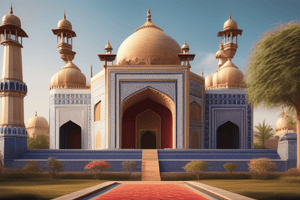Podcast
Questions and Answers
मुगल साम्राज्य की स्थापना किसने की थी?
मुगल साम्राज्य की स्थापना किसने की थी?
- हुमायूं
- बाबर (correct)
- शाहजहाँ
- उरंगजेब
किस सम्राट ने धार्मिक सहिष्णुता की नीति लागू की थी?
किस सम्राट ने धार्मिक सहिष्णुता की नीति लागू की थी?
- अौरंगजेब
- जहानगीर
- बाबर
- अकबर (correct)
ताजमहल किस सम्राट के शासन काल में बनाया गया था?
ताजमहल किस सम्राट के शासन काल में बनाया गया था?
- अकबर
- जहानगीर
- हुमायूँ
- शाहजहाँ (correct)
मुगल साम्राज्य का सबसे बड़ा विस्तार किस सम्राट के दौरान हुआ?
मुगल साम्राज्य का सबसे बड़ा विस्तार किस सम्राट के दौरान हुआ?
मंसबदारी प्रणाली किसके द्वारा स्थापित की गई थी?
मंसबदारी प्रणाली किसके द्वारा स्थापित की गई थी?
मुगल साम्राज्य के पतन के मुख्य कारण क्या थे?
मुगल साम्राज्य के पतन के मुख्य कारण क्या थे?
किस सम्राट के समय में मुगल चित्रकला का विकास हुआ?
किस सम्राट के समय में मुगल चित्रकला का विकास हुआ?
मुगल साम्राज्य की प्रशासनिक प्रणाली किससे प्रभावित थी?
मुगल साम्राज्य की प्रशासनिक प्रणाली किससे प्रभावित थी?
A good morning
A good morning
Flashcards are hidden until you start studying
Study Notes
Overview of the Mughal Empire
- The Mughal Empire was a prominent and influential empire in India from the early 16th to the 19th century.
- Founded by Babur in 1526 after the Battle of Panipat.
- The empire is known for its significant contributions to art, architecture, culture, and administration.
Key Emperors
-
Babur (1526-1530)
- First Mughal emperor.
- Established the empire after defeating Ibrahim Lodi.
-
Humayun (1530-1540, 1555-1556)
- Faced initial challenges and exile to Persia.
- Regained the throne with Persian assistance.
-
Akbar (1556-1605)
- Known for his policy of religious tolerance and administrative reforms.
- Expanded the empire significantly and established the Din-i Ilahi.
- Introduced the Mansabdari system for military and civil administration.
-
Jahangir (1605-1627)
- Focused on art and culture; patron of the arts.
- Continued Akbar's policies but faced challenges from nobles.
-
Shah Jahan (1628-1658)
- Known for monumental architecture, including the Taj Mahal.
- His reign is often considered the golden age of Mughal architecture.
-
Aurangzeb (1658-1707)
- Expanded the empire to its greatest territorial extent.
- His reign marked a shift towards more orthodox Islamic policies, leading to religious strife.
Cultural Contributions
- Architecture: Notable for grand structures like the Taj Mahal, Red Fort, and Fatehpur Sikri.
- Art: Development of Mughal painting, blending Persian and Indian styles.
- Literature: Flourishing of Persian literature and poetry.
Administration
- Centralized government with a complex bureaucracy.
- Revenue system based on land revenue; introduced the Zabt system.
- The Mansabdari system categorized officials by rank and responsibilities.
Decline
- The empire began to weaken after Aurangzeb’s death due to:
- Succession wars and internal conflicts.
- Economic challenges and regional uprisings.
- British colonial expansion in India during the 18th century, leading to the eventual dissolution of the empire.
Legacy
- The Mughal Empire left a lasting impact on Indian culture, architecture, and the socio-political landscape.
- The integration of diverse cultures and religions is a significant aspect of its historical legacy.
मुग़ल साम्राज्य का सामान्य विवरण
- मुग़ल साम्राज्य भारत में 16वीं शताब्दी से 19वीं शताब्दी तक एक प्रमुख और प्रभावशाली साम्राज्य था।
- इस साम्राज्य की स्थापना बाबर ने 1526 में पानीपत की लड़ाई के बाद की।
- कला, वास्तुकला, संस्कृति और प्रशासन में महत्वपूर्ण योगदान के लिए जाना जाता है।
मुख्य सम्राट
-
बाबर (1526-1530)
- पहले मुग़ल सम्राट, जिन्होंने इब्राहीम लोदी को हराकर साम्राज्य की स्थापना की।
-
हुमायूँ (1530-1540, 1555-1556)
- प्रारंभिक चुनौतियों का सामना किया और फारस में निर्वासित हो गए।
- फारसी सहायता से फिर से सिंहासन पर लौटे।
-
अकबर (1556-1605)
- धार्मिक सहिष्णुता और प्रशासनिक सुधारों के लिए प्रसिद्ध।
- साम्राज्य का विस्तार किया और 'दिन-ए-इलाही' की स्थापना की।
- सैन्य और नागरिक प्रशासन के लिए 'मानसबदारी प्रणाली' की शुरुआत की।
-
जहाँगीर (1605-1627)
- कला और संस्कृति पर ध्यान केंद्रित किया; कला का patron।
- अकबर की नीतियों को जारी रखा, लेकिन नवाबों से चुनौतियों का सामना किया।
-
शाहजहाँ (1628-1658)
- ताजमहल जैसी स्मारकीय वास्तुकला के लिए जाना जाता है।
- उनका शासन मुग़ल वास्तुकला के स्वर्ण युग के रूप में माना जाता है।
-
औरंगज़ेब (1658-1707)
- साम्राज्य का सबसे बड़ा भौगोलिक विस्तार किया।
- उनके शासन ने अधिक रूढ़िवादी इस्लामी नीतियों की ओर झकाव किया, जिससे धार्मिक तनाव बढ़ा।
सांस्कृतिक योगदान
- वास्तुकला: ताजमहल, लाल किला, और फ़तेहपुर सीकरी जैसी भव्य संरचनाएँ।
- कला: मुग़ल चित्रकला का विकास, फारसी और भारतीय शैलियों का समागम।
- साहित्य: फारसी साहित्य और कविता का उत्थान।
प्रशासन
- एक केंद्रीकृत शासन प्रणाली और जटिल प्रशासनिक संरचना।
- भूमि कर पर आधारित राजस्व प्रणाली; जब्त प्रणाली की शुरुआत की।
- 'मानसबदारी प्रणाली' में अधिकारियों की रैंक और जिम्मेदारियों का वर्गीकरण किया गया।
पतन
- औरंगज़ेब की मृत्यु के बाद साम्राज्य कमजोर होने लगा, जिसके कारण:
- उत्तराधिकार युद्ध और आंतरिक संघर्ष।
- आर्थिक चुनौतियाँ और क्षेत्रीय विद्रोह।
- 18वीं शताब्दी में ब्रिटिश उपनिवेशी विस्तार, अंततः साम्राज्य के विघटन की ओर अग्रसर।
विरासत
- मुग़ल साम्राज्य ने भारतीय संस्कृति, वास्तुकला और सामाजिक-राजनैतिक परिदृश्य पर स्थायी प्रभाव छोड़ा।
- विभिन्न संस्कृतियों और धर्मों का एकीकरण इस ऐतिहासिक विरासत का एक महत्वपूर्ण पहलू है।
Studying That Suits You
Use AI to generate personalized quizzes and flashcards to suit your learning preferences.




